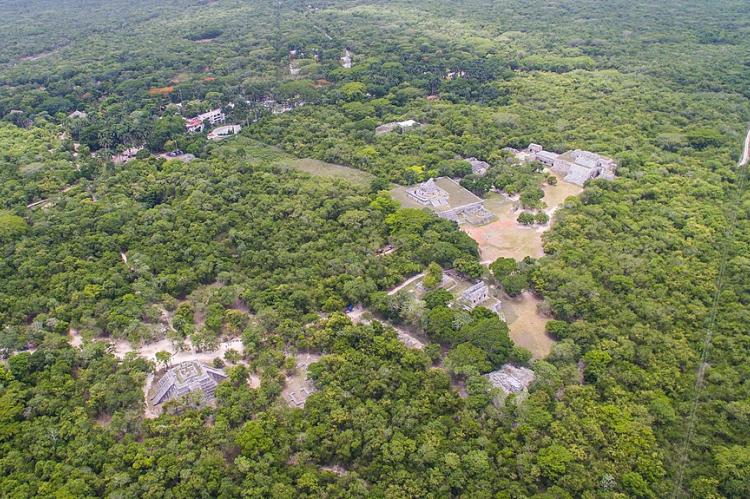The Yucatán Peninsula: Nature, Culture, and Geological Marvels
The Yucatán Peninsula is a vast landmass between the Gulf of Mexico and the Caribbean Sea. It includes three Mexican states and extends into Belize and Guatemala. The region boasts rich geological formations, lush jungles, and ancient archaeological wonders.
The Yucatán Peninsula
Nature, Culture, and Geological Marvels
The Yucatán Peninsula is a vast landmass situated between the Gulf of Mexico to the west and north and the Caribbean Sea to the east. It is a fascinating blend of diverse landscapes and cultural heritage. It covers approximately 197,600 square kilometers (76,300 square miles) and includes the Mexican states of Campeche, Quintana Roo, and Yucatán, extending into Belize and Guatemala to the south. The region boasts rich geological formations, lush jungles, and ancient archaeological wonders, all offering an opportunity to explore the intricate interplay of nature and civilization.

Political map of the Yucatan Peninsula.
Maya Forest
Enveloping the Yucatán Peninsula like a protective embrace, the Maya Forest is Central America's largest tract of forest. Stretching over 5 million hectares (13.3 million acres), it rivals the Amazon Rainforest in size. This verdant expanse is not merely a collection of trees but a complex ecosystem harboring breathtaking flora and fauna. From towering hardwoods to elusive jaguars, the Maya Forest is a testament to the region's ecological richness.
Archaeological Marvels
The Yucatán Peninsula is a treasure trove of ancient civilizations, with archaeological sites that narrate the story of the Maya people. Iconic locations like Chichén Itzá, Uxmal, and Tulum, designated as UNESCO World Heritage sites, bear witness to the architectural and cultural achievements of the Maya. These remnants of the past, amidst the lush jungles and limestone formations, provide a glimpse into the sophisticated societies that once thrived in this land.
Geological Marvels and Cenotes
The Yucatan Peninsula in Mexico is a geological wonder with a unique feature vital to the survival of the ancient and contemporary Maya communities. The Yucatan Platform, the landmass beneath the surface, primarily comprises limestone and other soluble rocks. This gives rise to the karst topography, characterized by thousands of natural sinkholes and underground rivers called cenotes. These cenotes punctuate the surface and serve as essential access points to the groundwater system. Over millennia, this unique geological feature has shaped the landscape and provided water for the region's inhabitants.

Relief map of the Yucatan Peninsula.
Asteroid Impact and the Chicxulub Crater
The Yucatán Peninsula contains evidence of a catastrophic event that changed Earth's history forever - the collision of an asteroid. The discovery of the Chicxulub Crater, situated just off the coast, provides tangible evidence of the mass extinction event that led to the extinction of the dinosaurs. The shocks from the impact have left their mark on the Yucatán's rocks, indicating a significant moment in the planet's geological timeline.
Climate Dynamics and Vulnerability to Storms
The Yucatán Peninsula experiences a range of climates, from the hot and dry north to the more humid south. It is located within the Atlantic Hurricane Belt, so the area is prone to powerful storms. Due to the region's flat terrain, hurricanes from the east can cause significant damage. Despite this vulnerability, the Yucatán Peninsula has proven resilient, with intense storms called "nortes" causing brief but impactful weather events throughout the year.
Biodiversity and Ecoregions
The Yucatán Peninsula boasts a rich tapestry of biodiversity, with short and tall tropical jungles dominating its natural vegetation. The region supports diverse flora and fauna, from deer and jaguars to vibrant birdlife. The Peninsula is home to various ecoregions, each characterized by distinct habitats:
-
Yucatán Moist Forests: Featuring dense, humid forests and housing threatened bird species like the great curassow.
-
Yucatán Dry Forests: Exhibiting an open, grassy landscape with adaptations to dry climates, including species like the collared peccary.
-
Yucatán Peninsula Freshwater Marshes: Hosting wetlands teeming with birds, reptiles, and amphibians.
-
Yucatán Peninsula Mangroves: These mangrove forests provide vital habitats for marine and coastal species along the coast.
-
Yucatán Peninsula Coral Reefs: Underwater ecosystems supporting diverse marine life, including fish, coral, and sponges.
The Yucatán Peninsula is a captivating area of geological marvels, cultural traditions, and ecological variety. It presents adventurers with a chance to uncover its secrets and appreciate its splendor, from the bottom of cenotes to the summit of ancient pyramids. This dynamic region weaves a story that spans centuries and embodies the heart of the Yucatán Peninsula.





